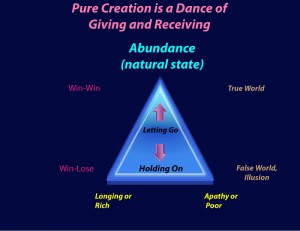By Cathy Eck
There’s no shortage of advice on the subject of manifesting desires. I’ve probably heard and tried it all at some point in my life. But often, after hanging out in those conversations, I’d find that I wasn’t manifesting my desires as promised.
Disillusioned, I’d think I just couldn’t get it. Sometimes I’d feel post-manifest guilt if I willed people or things into my life with visualization or affirmation. Often I was physically and mentally exhausted from my need to be spiritually worthy or keep my vibration tuned. Mental hard work had replaced physical hard work.
What Do You Really Want?
By the time people come to me, they’re often in pretty deep apathy. “I don’t want anything; I just want to be myself,” they say. I get it; I felt like that once. But apathy isn’t even close to freedom. They’re further from their True Self than they were before their first workshop. If you look at the our old triangle process, apathy and longing sit at the bottom of the triangle. We’ll hang out in longing until we give up, then we’ll laterally move over to apathy. People often mistake apathy for acceptance.
Rich and poor are another bottom of the triangle dynamic duo related to abundance. Jesus said that the rich can’t get to heaven because he knew that the rich have the poor hidden within their unconscious mind. They project their poor mindset on to others who take it because they’ve been taught to see money as evil. The rich would have to unveil their own poverty mindset and let their poor projection off the hook to get to abundance (heaven). He didn’t see them doing that.
Abundance got stretched out of form by new thought movements. Abundance to the initiates was a state of mind where you knew that whatever you needed or truly desired could be manifested with a single powerful thought. People often use the term abundance when they really mean rich or longing. This creates level confusion.
True Versus False Desires
Desires that feel calm and peaceful are true. When we can calmly enjoy something in our mind, it’s a true desire. If our desires comes laced with emotions, like excitement or jealousy, then either the false self is blocking them or they aren’t true desires. If desires remains after we let go of the false thoughts that are causing the emotion, they’re true desires; and they’re on their way to us. If our desires are false, they’ll disappear.
Here’s a technique that I give to people (and myself) a lot. Think of something you’ve wanted for a long time; picture it in your mind if you want. Noticed if any emotion arises in your body. Avoid labeling the emotion. Focus your attention on the emotion until a thought arises. Remember, don’t wallow in the emotion or analyze it, just witness it. Thoughts that arise out of the emotion will generally be contrary to your desire. It will appear to be true, but it’s not true. It could be a past reality because it happened to you before or you saw it in others, but we’re not trying to prove reality. We’re trying to get to the truth.
If you realize that the contrary thought isn’t true, you’ll be able to let it go. If you think it is true, you’re screwed. Your mind is blocking your desire. Until you can get rid of that contrary thought or thoughts, your only option to get the desire is to will it — to force it to manifest. That can work, but you’ll probably have post-manifest guilt.
Reality is the effect of the beliefs we’ve believed in the past. Until we let them go, they create in our life. You’re seeing the belief that caused the state you’re currently in. Beliefs always look true when they rise up from our unconscious mind. We suppressed them because they felt bad when we first heard them. They rise up wearing the same mask they wore when we suppressed them.
Always remember that you can’t let go of the true self. You can’t hurt anyone or anything by letting go. If you stay with this exercise until all the emotion is gone, you’ll see things clearly. Don’t get discouraged; this can take some work. Ideally, you don’t take any action until it’s inspired — in other words, it’s joyous and obvious.
Guilt or Shame
Let’s say that you go shopping and buy a new suit. It’s gorgeous, and you feel great. After driving home, emotion erupts. That means that a belief has been triggered by your action. If you put your “observer” attention on the emotion and listen, usually a belief will rear its ugly little fat head like, “I spent too much money.” If you accept that belief, you’re screwed. Your mind will go into reasoning, guilting, shaming, worrying, blaming, justifying, etc. But if you notice that the belief, “I spent too much money,” doesn’t feel good, so it isn’t the truth; and if you let it go, you’ll go right back to enjoying your suit.
People have to drug and sooth themselves because they don’t catch that first belief that arises after an action, and they go right down the toilet into the illusion’s sewage dump. That single, seemingly innocent, belief is the entry point into the illusion. Once the illusion has your ass, you’ll be stuck in its trap. If you don’t correct your thinking, you’ll eventually feel emotion with any purchase until you can barely buy a loaf of bread. People over time move from cautious, to thrifty, to cheap, to greed. The illusion is seductive. That’s why it’s rare that people get free.
Desires aren’t bad. But desires do piss off the illusion. Beliefs come out of hiding to fight for their life when we honor or raise our desires. If we are watchful and catch the false thoughts as they arise, we’ll not only get our desires, we’ll get freedom.


